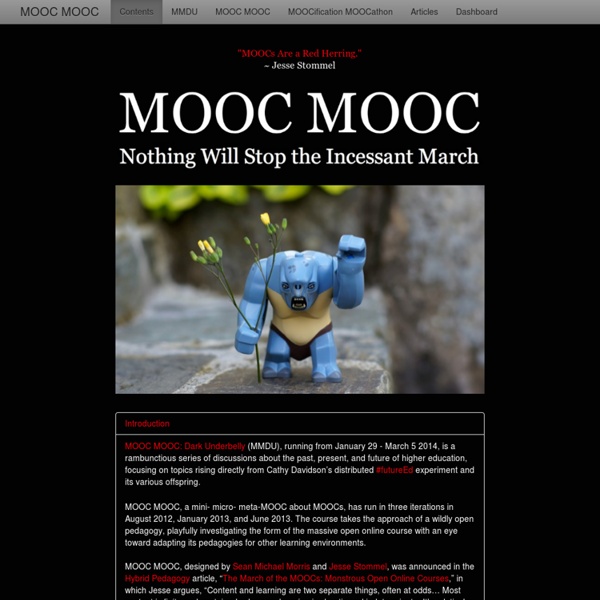



What is a connectivist MOOC? | Connectivist MOOCs “MOOCs” are massive open online courses. Dave Cormier introduces the MOOC: There’s a great written explanation of MOOCs in the introduction to the PLENK2010 MOOC Stephen Downes explains: This longer interview with George Siemens and Howard Rheingold is also a very helpful introduction to connectivism: August 2012′s MOOCMOOC was a one-week course led by Hybrid Pedagogy which examined the MOOC medium. As a springboard for more on MOOCs, check out the readings from Sunday and Monday and have a look at this piece on the MOOC Misnomer which does a nice job of dismantling lazy use of the term. A shorthand has emerged which distinguishes between connectivist courses – cMOOCs – and ones that are more broadcast-focused and reliant upon certification and peer testing. I’ve made my own attempt at distinguishing between xMOOCs and cMOOCs. This site exists to point people towards connectivist courses. xMOOCs are already excellently served by Class Central.
Khan Academy #ETMOOC | A MOOC about educational technology & media – Coming January 2013 Training Resources Three Kinds of MOOCs « Lisa By Lisa, on August 15th, 2012 We are so into MOOCs now that it’s too much for me. Gotta apply Ockham’s Razor 2.0 to this stuff. At the Ed-Media conference, I attended a session by Sarah Schrire of Kibbutzim College of Education in Tel Aviv. Each type of MOOC has all three elements (networks, tasks and content), but each has a goal that is dominant. Network-based MOOCs are the original MOOCs, taught by Alec Couros, George Siemens, Stephen Downes, Dave Cormier. Task-based MOOCs emphasize skills in the sense that they ask the learner to complete certain types of work. Content-based MOOCs are the ones with huge enrollments, commercial prospects, big university professors, automated testing, and exposure in the popular press. So I’m rejecting both the Good vs Bad MOOC model, and the million-points-of-MOOC approach, and going for a triad.
Udacity artlcle Udacity gives students videos that they can watch at their own pace and be continually quizzed on. This past August fellow Singularity Hub writer Aaron Saenz wrote about Udacity, the online university created by Stanford artificial intelligence professor and Google autonomous vehicle leader, Sebastian Thrun. At the time Thrun was gearing up to teach his Introduction to Artificial Intelligence course to a class of 200 at Stanford. But why teach 200 when you can teach 1,000…or 160,000? With Udacity, Thrun and fellow AI giant Peter Norvig created an online version of the course, and anyone that wanted to enroll could – for free. Now, the semester’s over. Online, the course went viral. Thrun also proudly pointed out that he was teaching more students than all the students of Stanford. The lessons themselves were very simple – at least in method if not in content. The flexibility that this format offers is immediately clear. Until you get it right. What will education look like in the future?
Khan Academy (khanacademy) MOOC Platforms Welcome to MOOC.CA ~ MOOC edX (edXOnline) Mooc Resources Connection not Content